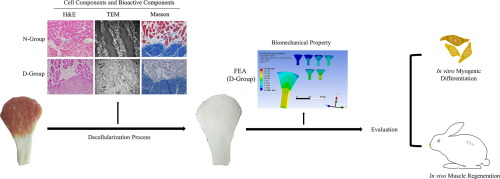Acta Biomaterialia ( IF 9.7 ) Pub Date : 2017-12-30 , DOI: 10.1016/j.actbio.2017.12.035 Chenchen Zhao , Shengyu Wang , Gangliang Wang , Mingzhen Su , Liyang Song , Jiaxin Chen , Shunwu Fan , Xianfeng Lin

|
Muscle injury and defect affect people's quality of life, and effective treatment is lacking. Herein, we generated a scaffold to obtain decellularized porcine Achilles tendon myotendinous junction (D-MTJ) extracellular matrix (ECM) with well-preserved native biphasic hierarchical structure, biological composition, and excellent mechanical properties for muscle regeneration. The combined use of potassium chloride, potassium iodide, Triton-X 100, and sodium-dodecyl sulfate (SDS) can completely remove the main immunogenicity, while maintaining the major biological components and microstructure. The specific biomechanics of D-MTJ is comparable to the native muscle-tendon physiological conditions. Additionally, the D-MTJ ECM scaffold induced minimal immunological reaction (histology analysis) through rat subcutaneous implantation. Moreover, in vitro, muscle satellite cells adhered, proliferated, and infiltrated into the D-MTJ scaffold, and myofiber-like cell differentiation was observed as shown by increased expression of myogenesis-related genes during culture. In vivo, newly formed myofibers were observed in a muscle defect model with D-MTJ orthotopic transplantation, while the control group presented mostly with fibrous tissue deposition. Additionally, the number of Myod and MyHC-positive cells in the ECM scaffold group was higher at day 30. We preliminary explored the mechanisms underlying D-MTJ-mediated muscle regeneration, which may be attributed to its specific biphasic hierarchical structure, bio-components, and attractiveness for myogenesis cells. In conclusion, our findings suggest the D-MTJ ECM scaffold prepared in this study is a promising choice for muscle regeneration.
Statement of significance
This study is the first to use decellularization technology obtaining the specifically decellularized myotendinous junction (D-MTJ) with well-preserved biphasic hierarchical structure and constituents, excellent mechanical properties and good biocompatibility. The D-MTJ was further proved to be efficient for muscle regeneration in vitro and in vivo, and the underlying mechanisms may be attributed to its specifically structure and constituents, improved myogenesis and good preservation of repair-related factors. Our study may provide basis for the decellularization of other biphasic hierarchical tissues and a platform for further studies on muscle fiber and tendon integrations in vitro.
中文翻译:

用于肌肉再生的脱细胞双相递阶肌腱接头细胞外基质的制备
肌肉损伤和缺陷影响人们的生活质量,缺乏有效的治疗方法。在这里,我们生成了一个支架,以获得脱细胞的猪跟腱肌腱接头(D-MTJ)细胞外基质(ECM),其具有良好保存的天然双相分层结构,生物学组成和出色的肌肉再生机械性能。氯化钾,碘化钾,Triton-X 100和十二烷基硫酸钠(SDS)的组合使用可以完全去除主要的免疫原性,同时保持主要的生物学成分和微观结构。D-MTJ的特定生物力学与天然肌腱的生理条件相当。另外,D-MTJ ECM支架通过大鼠皮下植入诱导了最小的免疫反应(组织学分析)。而且,在体外,肌肉卫星细胞粘附,增殖并渗透到D-MTJ支架中,并观察到肌纤维样细胞分化,这由培养过程中与肌生成相关基因的表达增加所表明。体内,在D-MTJ原位移植的肌肉缺损模型中观察到新形成的肌纤维,而对照组则主要表现为纤维组织沉积。此外,ECM支架组中的Myod和MyHC阳性细胞数量在第30天较高。我们初步探讨了D-MTJ介导的肌肉再生的潜在机制,这可能归因于其特定的双相层次结构,生物成分以及对成肌细胞的吸引力。总之,我们的发现表明,本研究中制备的D-MTJ ECM支架是肌肉再生的有前途的选择。
重要声明
这项研究是首次使用脱细胞技术获得具有良好保存的双相分层结构和成分,优异的机械性能和良好的生物相容性的专门脱细胞的肌腱接头(D-MTJ)。D-MTJ被进一步证明在体外和体内对肌肉的再生都是有效的,其潜在机制可能归因于其特定的结构和组成,改善的肌发生和修复相关因子的良好保存。我们的研究可能为其他双相分层组织的去细胞化提供基础,并为进一步研究体外肌纤维和肌腱整合提供了平台。



























 京公网安备 11010802027423号
京公网安备 11010802027423号